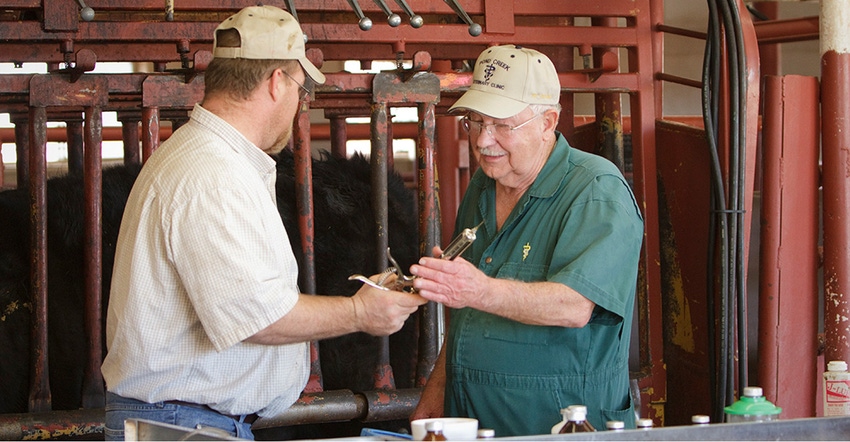Antimicrobial stewardship can help maximize disease-prevention and ensure proper use of antimicrobials.

Every livestock producer’s to-do list for February should include an in-depth review of his or her operation’s antimicrobial stewardship program, according to Oklahoma State University Extension recommendations.
Since the introduction of antimicrobials in the 1940s, illness and deaths in both people and animals from infectious diseases have been greatly reduced. However, given that these drugs have been used so widely for so long has resulted in bacterial adaptation, with many becoming resistant. Antimicrobial stewardship is a coordinated effort by physicians, veterinarians, animal caretakers and agricultural producers to preserve the effectiveness of antimicrobial drugs.
Effective antimicrobial stewardship requires commitment from all members of an operation’s animal health team to maximize disease-prevention procedures and ensure the proper use of antimicrobials, said Dr. Rosslyn Biggs, OSU Extension veterinarian and director of continuing education for the university’s College of Veterinary Medicine.
“An operation’s antimicrobial stewardship program begins with the veterinary-client-patient-relationship,” she said. “Initial discussions between a producer and veterinarian should focus on prevention of disease through evaluation of biosecurity and animal husbandry practices. Periodic evaluations of vaccinations protocols, stress reduction practices and nutrition will allow livestock producers to enhance already existing processes.”
OSU Extension recommendations are for producers and their veterinarians to:
Consider disease testing of all new animals introduced into an operation.
Screen established herd members based on established risk factors.
Develop goals for reduction in disease incidence through accurate recordkeeping and benchmarking.
Once procedures have been reviewed and goals established, the next priority is training animal health team members. Training can enhance understanding of husbandry practices, biosecurity, disease symptoms, treatment protocols and record keeping.
Antimicrobial administration should focus on safety of all personnel and animals, as well as the final consumer product, Biggs said.
“One way to ensure this is to develop written, specific treatment protocols with appropriate prescriptions in place for commonly seen diseases,” she said. “These protocols, along with treatment records, should be reviewed annually. However, some operations will require reviews be done quarterly, or perhaps even more frequently. Again, the attending veterinarian for an operation can provide insights and recommendations.”
Evaluate disease rate, treatment frequency and treatment outcomes during these reviews. Changes in protocols should be based on operation data and scientific evidence.
“Antimicrobials should never be administered on a hunch,” Biggs said. “Diagnosis of disease must occur through accurate knowledge of an animal’s history, examination and clinical experience by a veterinarian and, when warranted, diagnostic testing. Consider these safeguards in the fight against antimicrobial resistance.”
Another safeguard is to always administer antimicrobials according to label directions. Labels and prescriptions are designed to both promote the best return on antibiotic investment and prevent the development of resistance. Extra-label drug use should be considered only in extenuating circumstances, and there should be no deviation from the veterinarian’s prescribing instructions.
Veterinarians carry a significant responsibility for antimicrobial stewardship, Biggs said. This includes a professional responsibility to:
Stay current on continuing education, ongoing therapeutic data and research.
Be aware of and ensure compliance with applicable state and federal laws regarding proper on-farm use of the medications.
Help clients evaluate treatment records and assess disease outcomes.
“America’s livestock industry has been working diligently to promote widespread antimicrobial stewardship,” said Bob LeValley, Oklahoma Beef Quality Assurance coordinator. “We’ve seen significant progress in all aspects of the food production chain in terms of overall awareness and use of best management practices in the past decade. Support throughout the U.S. Government has played a major role in the adoption of antimicrobial stewardship.”
The U.S. Food and Drug Administration’s Veterinary Feed Directive rules, as an example, outlines the process for authorizing drugs intended for use in or on animal feed that require the supervision of a licensed veterinarian. This has provided a framework for authorizing the use of medically important antibiotics – those that are important to human health – when needed for specific animal health purposes.
“There are many practical things livestock operators can and should do to ensure antimicrobial stewardship,” LeValley said. “Producers should look at their veterinarians as part of their team, and never be shy about asking for advice specific to their operation.”
The Centers for Disease Control and Prevention supports the judicious use of antibiotics in people and animals, including efforts by the U.S. Department of Agriculture to improve antimicrobial use in veterinary medicine and agriculture.
Fact sheets detailing research-based information about livestock health and disease management, animal well-being and waste management are available online and through OSU Extension county offices.
Source: is OSU, which is solely responsible for the information provided and is wholly owned by the source. Informa Business Media and all its subsidiaries are not responsible for any of the content contained in this information asset.
About the Author(s)
You May Also Like



